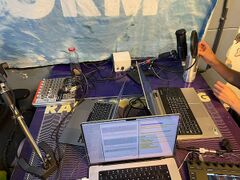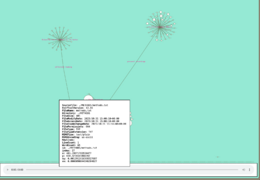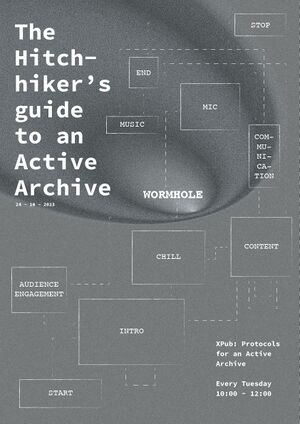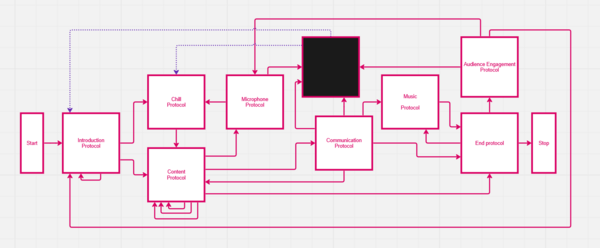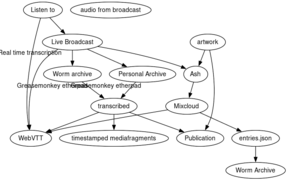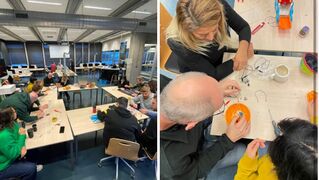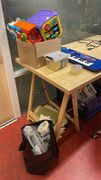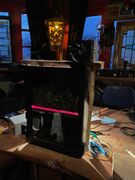User:Vitrinekast
pandoc --from markdown --to mediawiki -o ~/Desktop/{{file_name}} {{file_path:absolute}}
Overall, i think i can reduce the things im working with to the following verbs (or ’ings):
- HTML’ing
- Repair’ing (Or break’ing)
- Sound’ing
- Radio’ing
- Solder’ing
- Workshop’ing
- developing the interest in Permacomput’ing
- Server’ing
XPUB Changelog
September
- Start XPUB with a read-tru of the manual
- SI22 is about radio, transmission
(not to be confused with my best experience of the summer, Touki Delphine’s transmission(reference). Their work, a 20 minute audio/light experience performed by car parts was mesmerising and super inspiring, as I am still trying to figure out ways of performance without actually being there. )
- Prototyping: making graphs with graphviz, blast from the past with installing chiplotle.
I’ve used the thermal printer/plotter tru chiplotle to be able to create my letter for joining XPUB. At the time, installing chiplotle was such a drag that I wasn’t very motivated to redo it on this new machine. But, it turns out it was way easier then I remember it being the first time!
The topics discussed by Ola Bonati were very recognisable, and something i’d love to explore further. The future of software is nintendo DS! (Reference)Not very interested in the demoscene in all honesty. Their response to the question “How is this related to permacomputing”, was “small file sizes”, and this contest of creating the most efficient line of code is not that appealing to me.
October
- Zine camp
Earlier I made a node based representation of the worm archive, of which Manetta gave the very good feedback of asking what it was other then a fancy visual (not exactly those words!), and she was very right about this. I just wanted to play around with the file structure. But the basis of this was (going to be) used during the presentation at Zine Camp. The screenshot below shows the updated version, which includes loads of metadata extracted from the files at the archive. Unfortunately due to some personal things, I wasn’t able to join the presentation.
Transcluded wiki page of Granularchive
The Granularchive is a proposal to use as a tool during the presentation & radio broadcast of Zine Camp 2023, part of the Radio Worm: Protocols for an Active Archive Special Issue. Currently, the Granularchive can be visited via ChopChop.
The Granularachive previews all contents of an archive, by making use of exiftool (which is already installed on ChopChop). The content is displayed by translating a JSON file into the interactive SVG graph using D3.js. D3.js is an open-source javascript library.
Updating the Granularachive
- Upload new contents to the Granularchive folder on ChopChop via
/var/www/html/archive_non-tree→ name to be updated - Within this folder, run
exiftool -json -r . > exiftool.json, which will generate exiftool.json - Make sure this exiftool.json is placed at the root of `/var/www/archive_non-tree', and overwrite the existing one. Now the tool is updated!
An extra step will be needed to also include all of the wordhole content into the granularchive
Example of exiftool.json
The data displayed below can be used to change the way the Granularchive is presented.
{
"SourceFile": "./hoi/Folder1/Radio_Show_2008_3.mp3",
"ExifToolVersion": 12.5,
"FileName": "Radio_Show_2008_3.mp3",
"Directory": "./hoi/Folder1",
"FileSize": "0 bytes",
"FileModifyDate": "2023:10:28 23:16:26+02:00",
"FileAccessDate": "2023:10:30 08:39:14+01:00",
"FileInodeChangeDate": "2023:10:28 23:17:20+02:00",
"FilePermissions": "-rw-r--r--",
"Error": "File is empty"
},
- Created a mixer for Mixcloud (Wiki documentation).
Control the audio by moving the cursor. The snippet can be pasted into the console of a browser. I really enjoy this method of circuit bending existing webpages.
Transcluded wiki page of Mixercloud
Copy-paste this into your console! (Right click -> inspect elements > console)
Remix Mixcloud
(copy paste it into the console of your browser when visiting mixcloud.com)
var remixCloud = function () {
var audio = document.querySelector("audio");
var svgs = document.querySelectorAll("svg");
var h1s = document.querySelectorAll("h1, h2, h3,button,img");
var as = document.querySelectorAll("a");
var timeout;
document.addEventListener("mousemove", function (e) {
if (!timeout) {
timeout = window.setTimeout(function () {
timeout = false;
var r = 3 * (e.clientY / window.innerWidth) + 0.25;
audio.playbackRate = r;
audio.currentTime = audio.duration * (e.clientX / window.innerWidth);
svgs.forEach((el) => {
el.style.transform = `scale(${(r, r)})`;
});
as.forEach((el) => {
el.style.transform = `rotate(${r * 20}deg)`;
});
document.body.style.transform = `rotate(${r * -4}deg)`;
h1s.forEach((el) => {
el.style.transform = `rotate(${r * 10}deg)`;
});
}, 100);
}
});
};
remixCloud();Adding audio elements to index files
// select all links
document.querySelectorAll("a").forEach((link) => {
// if it includes your audio format (regex)
if(link.href.match(/\.(?:wav|mp3)$/i)) {
// create an audio element and set its source to yourlink
var audioEl = document.createElement("audio");
audioEl.src = link.href;
audioEl.controls = true;
audioEl.style.display = "block";
link.insertAdjacentElement("afterend", audioEl)
};
// or an image
if(link.href.match(/\.(?:jpg|png)$/i)) {
var imgEl = document.createElement("img");
imgEl.src = link;
imgEl.style.display = "block";
link.insertAdjacentElement("afterend", imgEl)
}
});
- Experimented with recording my found german wall clock. Not a lot of luck yet using pickups, but later i’ve discovered that maybe piezo discs could be something, and to take a look at the open source schematics around using piezo’s as triggers.
- Tried out super collider
- Dealt with the broken laptop and spent way too much time in an apple store.
- Created the The Hitchhiker’s Guide to an Active Archive! At Radio Worm! Almost forgot about the fact that I originally joined Fine Arts to make games. Oh how the times change.
Transcluded wiki page of The Hitchhiker’s Guide to an Active Archive
The Hitchhiker's Guide to an Active Archive is the sixth radio show (including the Holiday Special) of the radio program XPUB: Protocols for an Active Archive on Radio Worm. The show aired on 2023 - 10 - 24 and was part of Special Issue 22.
Flowchart
A recording of the broadcast
Links
EtherPad for communicating with the Caretakers during the show: https://pad.xpub.nl/p/SI22-shownotes-week5
How this Wiki was used during the show
The Hitchhiker's Guide to an Active Archive was a radioshow broadcast on Radio Worm on 2023-10-24. It is an interactive radio play that was performed live by XPUB students Rosa, Anita and Thijs. They each voiced one of the three voices present in the script. The show could be recreated using these wiki pages and a fresh channel of communication (e.g. another EtherPad). Click 'START BROADCAST' to enter the beginning of the script. It is not linear, most sections allow for several follow-ups, depending on audience decisions, dicerolls, time requirements and performer intuition. The overall structure is captured in the flowchart above. Throughout the script, clickable links are placed at the places where the narrative branches. Also, soundeffects, audio fragments and musical clips are inserted in the script at the place they would be played (often accompanied by an instruction).
References, inspiration and further reading / playing / listening
This show was made in response to / inspired by several works, some of which are presented below.
- The Hitchhiker's Guide to the Galaxy: a 1978 BBC radio play written by Douglas Adams, that was later adapted into books and a movie.
- Georges Perec, his works Die Maschine and The Art of Asking Your Boss for a Raise, and this text on these works by Hannah Higgins (chapter 2 of Mainframe Experimentalism)
Also, here are some follow-up links if this show resonated with you and you'd like to experience more choose your own adventure adventures, branching narratives, etc. These were also part of our conversations when preparing the show.
- Her Story: an interactive film video game in which the player sorts through video clips from a set of fictional police interviews to solve the case of a missing man.
- Heaven's Vault: a scifi branching narrative game about an archeologist deciphering an ancient language.
- In class we also briefly discussed text adventure games -- and CYOA books -- like 1976's Colossal Cave Adventure and 1977's ZORK. These then also evolved into MUDs (Multi User Dungeons), which in turn evolved into a plethora of other video game genres.
November
- Experimenting with the media fragments API after a recommendation of Michael.
Using ==metadata== coming from the worm archive.
Transcluded wiki page of the media fragments API tests
This page looked so much better in markdown...
Example of a media fragment URI URL: http://www.example.org/video.ogv?t=60,100#t=20
Text below is from the Media Fragments URI 1.0 (basic)
The names and values can be arbitrary Unicode strings, encoded in UTF-8 and percent-encoded as per RFC 3986. Here are some examples of URIs with name-value pairs in the fragment component, to demonstrate the general structure:
* http://www.example.com/example.ogv#t=10,20 * http://www.example.com/example.ogv#track=audio&t=10,20 * http://www.example.com/example.ogv#id=Cap%C3%ADtulo%202
Media fragment URI can be used on video, images, and audio(?) → altough mentioned in the spec as video only(?) but what is a video anyway...
Used on image
Following URL should show a cropped image, but it does not appear to work onchrome.http://placekitten.com/500#xywh=percent:5,25,50,50
https://caniuse.com mentions that all browsers that have implemented something of this spec, have actually only implemented support for the #t=n,n control for selecting a range of video, and possibly track=(name) & id=(name).
Used in Audio!
I've uploaded some files to chopchop to test with
- https://hub.xpub.nl/chopchop/~vitrinekast/videos/small.3gp
- https://hub.xpub.nl/chopchop/~vitrinekast/videos/small.flv
- https://hub.xpub.nl/chopchop/~vitrinekast/videos/small.mp4
- https://hub.xpub.nl/chopchop/~vitrinekast/videos/small.ogv
- https://hub.xpub.nl/chopchop/~vitrinekast/videos/small.webm
- https://hub.xpub.nl/chopchop/~vitrinekast/videos/song.mp3
- https://hub.xpub.nl/chopchop/~vitrinekast/videos/song.flac
The following URL should only play the video from 00:01 to 00:02!
https://hub.xpub.nl/chopchop/~vitrinekast/videos/small.ogv#t=1,2
And... For mp3 it seems to work as wel!!
https://hub.xpub.nl/chopchop/~vitrinekast/videos/small.mp3#t=1,2
However, it does seem to fully load the file, when inspecting the request, which does not save any data being downloaded.
However 2: when throttling the request to slow3g, only 277 bytes are being downloaded according to the network tab. Something to investigate further.
- Check with charles to see if the amount of bytes are actually correct, as a reduced amount of bytes downloaded could be a positive result of using this to interact with an archive
- However, in terms of radio, m3u8 files are already broadcasted in "blobs" → so maybe this is more relevant to look into
Further checking and reading the spec
A glossary from the spec
Media fragments support addressing the media along two dimensions (in the basic version):
temporal This dimension denotes a specific time range in the original media, such as "starting at second 10, continuing until second 20";
spatial this dimension denotes a specific range of pixels in the original media, such as "a rectangle with size (100,100) with its top-left at coordinate (10,10)";
Media fragments support also addressing the media along two additional dimensions (in the advanced version defined in [Media Fragments 1.0 URI (advanced)](https://www.w3.org/TR/media-frags/#mf-advanced)):
track this dimension denotes one or more tracks in the original media, such as "the english audio and the video track";
id this dimension denotes a named temporal fragment within the original media, such as "chapter 2", and can be seen as a convenient way of specifying a temporal fragment.
- Spatial Dimension does not seem to work in chrome → clipping the video frame
- I'm not entirely sure yet what id/track should do, and also how to set this metadata, if it is even metadata?
- I tested https://hub.xpub.nl/chopchop/~vitrinekast/videos/small.mp4#track=audio but this still loads the full video instead of only the audio track. That could be great otherwise for the archive.
next steps
- Furher understand the Media fragment URI and what the current state of the spec is
- Read about [OggKate - XiphWiki](https://wiki.xiph.org/OggKate) an open source codec which could be used for Karaoke, but essentially allows for attaching time based metadata (see example below)
event {
00:18:30,000 --> 00:22:50,000
meta "GEO_LOCATION" = "35.42; 139.42"
meta "DATE" = "2011-08-12"
}
- this2that:
Used graphviz to together with riviera figure out some small tools we could make for the worm archive.
- Machine voice workshop by Ahnjili ZhuParris
Super interesting workshop, enjoyed the usage of these codelabs as a method of (self)documenting the code. I am a bit hesistant in experimenting with tools like machine learning, AI, etc. As i personally find them (but also know to little about this to make any actual statements) to use too much computing power to justify my own experimentation. It does tickle my beatboxing bone that I might want to use my own voice more as a source sound, in all of the sound device making.
December
Workshop at GR.Video:File:Workshop vid.mp4
- Hosted workshop Circuit Bending at Grafisch Lyceum
Grafisch Lyceum wants to make their Software Development MBO more “creative”, and therefore organises inspiratiesessies to generate new ideas for courses in the teaching departement. During the workshop, I’ve shared a bit about my practice, but we’ve mostly spent time doing some bending! I was pleasantly surprised with how much we got done, and how much fun it is to play with your instrument over a big speaker.
- attended Workshop Permacomputing @ Fiber
A 2 day workshop called Networking with Nature | Connecting plants and second-hand electronics hosted by Michal Klodner & Brendan Howell. Super interesting workshop with very interesting and diverse attendees. For instance, there was one person that researched getting electricity out of mud. ==(PIcture/video)==
- SI22: Listen Closely
Transcluded wiki page of Listen closely
Positioned around the space are FM radio transmitters broadcasting content from Special Issue #22. These were soldered together in the studio. The transmitters are connected to an audio interface which is itself connected to a Raspberry Pi. On the Pi, Open Sound Control (OSC) messages are sent back and forth between a Python application and Supercollider, an open-source, sound synthesis engine. OSC is a protocol which aims to standardise communication between audio applications.
Radio waves are agents for public commons. Resonating through communities tuning people together. It can reach far beyond where any human will ever go. By organizing multiple FM transmitters in a confined space and tuning them to the same frequency, an isolated ecosphere of electromagnetic waves is induced. To receive the hymn of the FM signals, equip yourself with a receiver. Let your movement in space be the interface in which you engage with the signals, and experience the proximity of the radio. So take your time, and listen closely.
Ultimatly, the project didn’t fully work. But it almost did, and I think that already counts. It also resulted in my first XPUB all-nighter, where we took ChopChop and all of the audio interfaces home, to continue working after the WH building would close. Together with the Factory we’ve soldered together many radio’s, which would be used by visitors to listen to the various radio streams. If i were to create this project again, I think I wouldn’t use Supercollider, mostly due to the fact that I’m not familiar with it. And, more importantly, I would prepare for a bit more fallbacks. But YOLO.
(PIcture/video)
- Started development of the web comic! Together with a comic maker, we’ve started translating their comic “Writing down good reasons to freeze to death” to the web. The plan at the moment, is to divide the comic into multiple chapters. Readers can sign up for a mailing, and will receive a new chapter every week(ish), to make it a bit more into a slow-paced experience. We’re very inspired by the game Florence, and what remains of edith finch We’ll be using sprite-based animations, audio and low-key gamification elements to tell the story. But it’ll take a long time before this is finished.
(PIcture/video)
- Took the leap and, after being advised by someone at operator not to, decided to start my eurorack path. ## Januari
- Joined the first JS club about jQuery
- Saw Soulwax in paradiso. Who knew 3 drummers were better then one.
- Battle of the node_modules, inner debates around frameworks
- Using Pure data to create a granullar synthesizer, and investigating further on how to do this on a raspberry Pi. I think it’s great to make use of the tools i’m already familiar with, such as pure data, instead of deep-diving in a new technique every three months. ==elaborate and pic==
- Made my first eurorack module from a kit, it doesn’t work. :(
Februari
- JS club about Vue,
- Oud-Charlois PCB-Dérive ==(PIcture/video)==
- Started to investigate installing linux (or other webservers) on ipads, android phones and my old macbook. Only took 2 months to get the first linux installation going. Then discovered; what is the point of running a webserver if it’s just for yourself?
The ongoing headache of getting an android phone to work as a webserver
This document follows the process of me trying to figure out how to set up a web server on various devices. Please note that this was really not a seamless experience, and every step of the way is just me trying things (over and over again). It’s more written like an ongoing conversation with myself to keep track of things.
It’s a Sony Xperia z5, and I’d like it to work as a webserver, as I already had it lying around and it would be an interesting alternative to a non-portable-server.
- Install documentation of postmarketOS Installation - postmarketOS
- I have to use pmbootstrap in order to install postmarketOS on the android phone
- I need linux in order to install it, so first installing linux trough UTM on my macbook No luck yet with installing, as the postmarketOS documentation is a bit all over the place. But i did find an article about running a webserver on the android device, might be interesting: How to host a Static Website on your Android Phone
- install f-doid
- install termux
- enable ssh
Unlock the bootloader via the Sony website instructions
Steps taken:
- check if bootloader is possible on the device
- In your device, open the dialer and enter ##7378423## to access the service menu.
- Tap Service info > Configuration > Rooting Status. If Bootloader unlock allowed says Yes, then you can continue with the next step. If it says No, or if the status is missing, your device cannot be unlocked.
- Download the [platform tools](https://developer.android.com/tools/releases/platform-tools
- enable USB debugging and the developer tools on the android device
- figure out the IMEI to unlock the unlock code by dialling
*#06#354187075829298- fill in that number in the unlock code generator
E43DC85FEDAC79C5
- connect to fastboot
- turn off device
- press volume up on device
- keep it and plug into usb
- in the extracted platform tools folder, run
./fastboot devices - verify that there are no errors
- enter unlock key
now i ran
pmbootstrap flasher flash_rootfs pmbootstrap flasher flash_kernel
Now it should work, but it is in a startup loop so i tried again
$ pmbootstrap build linux-sony-sumire $ pmbootstrap build device-sony-sumire $ pmbootstrap install --android-recovery-zip $ pmbootstrap flasher --method=adb sideload
hmm. i did some undocumented things, to get out of the loop. ultimately i ran:
$ pmbootstrap initfs hook_add maximum-attention $ pmbootstrap flasher boot
which took it into a loop, as documented in the wiki. so i removed the hook, and now it is loading the postmarket os for a little while, stating on the devices screen that its resizing the partition now its loading…
screen is stuck… restarting the device
and its back in the sony loop
I’ve tried all of the above 2x, but keep getting the same result… This issue is documented on the PostMarketOS wiki, so it might be unusable unfortunatly.
upload pic
The ongoing headache of getting an android phone to work as a webserver
This document follows the process of me trying to figure out how to set up a web server on various devices. Please note that this was really not a seamless experience, and every step of the way is just me trying things (over and over again). It’s more written like an ongoing conversation with myself to keep track of things.
Debian
I’ve by now installed Debian 12, and need to install a package without internet. i’ve put it on a usb stick
- to mount the usb stick to the mac
lsblkto list all devicesmkdir /media/usb-drivemount /dev/{name} /media/usb-drive/
- now we need to run the deb file using dpkg
dpkg -i {package}.debdont forget tosudo umount /media/usb
but now i get
dpkg: warning: 'ldconfig' not found in PATH or not executable. dpkg: warning: 'start-stop-daemon' not found in PATH or not executable.
so i did
su -
The package now installs, but it depends on wget, which is another package. So lets try to get internet by downloading the networkmanager
which needed many many dependencies, dependant on dependencies…
oh, but apparently networkManager is already installed? After I ran systemctl status NetworkManager it showed as inactive, so i restarted it using restart.
systemctl enable NetworkManager
im now installing zlibnm0_1.46.0-1_amd64.deb, which is needed to run nmcli (NetworkManager_?
so, that helped. now i can see that the wifi is on. but when running nmcli dev wifi list its still not showing any wifi spots. according to the internet i need to sudo systemctl start wpa_supplicant.service. but ofcourse, wpa_supplicant.service is not found…
This documentation is getting so chaotic
New day, new option: installed wireless tools
iwlist wlan0 scan
but this wireless chip doesn’t support scanning..?
And then I accidentally deleted the /usr folder, which broke the entire system. I couldn’t even ls anymore! Time to call it a day.
Michael left a usb stick on the laptop with a new installation of Debian 12. I’ve installed this one on the macbook, but keep running in the same issues. By now, I have gotten fast in mounting and unmounting USB sticks and manually downloading packages (that need packages and packages and packages).
Apparently I’m in need of specific non-free (free as in libre?) frameworks for the wifi card to work, but these honestly needed so many dependencies that needed to be manually downloaded one by one, that I gave up and went home.
Not the most seamless experience, and especially not the most empowering one (so far).
Ubuntu Server
Reverted so many things, installed Ubuntu server via the USB→ ethernet dongle of Michael, and now there is a server that can be ssh’d into! Ubuntu is supposed to be a bit more friendly out-of-the-box, so hopefully that will help me out. Time to finally get working on setting up the rest of the server, in more managable smaller steps: ### Things needed from a web server
- ☐ the ip address keeps changing. how to make this stay the same? ATM it stays the same, to look into what to do if you’ve lost the ip address..
- ☒ how to get wifi with eduroam to work?
- ☐ Fix this warning: Permissions for /etc/netplan/50-cloud-init.yaml are too open. Netplan configuration should NOT be accessible by others.
- ☐ Set the correct timezone
- ☒ resize terminal text size
- ☐ webserver
- ☒ Changing the font-size of the macbooks display
- ☐ SSH from a different location
- ☐ Git intergration?
- ☐ 404 pages
- ☐ FTP access
- ☐ being able to upload files
- ☐ Do not shut down when lid is closed - research other ways of lowering power consumption and extending shelf life.
- ☐ ehh how does DNS work?
- ☐ Think about if you’d want to self host gittea.
- ☐ change password to something more secure
How do i get the wifi of eduroam to work?
according to this gist, i need to create /etc/netplan/50-cloud-init.yaml. with the following setup
# This file is generated from information provided by the datasource. Changes
# to it will not persist across an instance reboot. To disable cloud-init's
# network configuration capabilities, write a file
# /etc/cloud/cloud.cfg.d/99-disable-network-config.cfg with the following:
# network: {config: disabled}
network:
ethernets:
eth0:
dhcp4: true
optional: true
wifis:
wlan0:
dhcp4: true
access-points:
"eduroam":
auth:
key-management: eap
password: "your password"
method: ttls
identity: "number@hr.nl"
phase2-auth: "MSCHAPV2"
version: 2
and then run sudo netplan --debug apply to apply the setup. the debug does show this warning, so i need to do something about it:
** (process:1657): **WARNING** **: 12:17:05.453: Permissions for /etc/netplan/50-cloud-init.yaml are too open. Netplan configuration should NOT be accessible by others. according to the logs, wpa_supplicant is created. but then: `A dependency job for netplan-wpa-wlan0.service failed. See 'journalctl -xe' for details.` and the apply is failed..
journalctl -xe returns
Mar 06 12:18:35 vitrinekast systemd[1]: **sys-subsystem-net-devices-wlan0.device: Job sys-subsystem-net-devices-wlan0.device/start timed out.** Mar 06 12:18:35 vitrinekast systemd[1]: **Timed out waiting for device /sys/subsystem/net/devices/wlan0.**
Did some searching, and removed this whole thing to try something else
installed NetworkManager to be able to run nmcli d. It is so much better to do this with an internet connection!
**rosa@vitrinekast**:**~**$ nmcli d DEVICE TYPE STATE CONNECTION wlp3s0 wifi disconnected -- enx00249c032885 ethernet unmanaged -- lo loopback unmanaged -- **rosa@vitrinekast**:**~**$
then I turn the wifi on by nmcli r wifi on. listing the available networks by running nmcli d wifi list returns loads of Tesla wifi networks! But also some eduroam.
nmcli d wifi connect my_wifi password <password>
gives Error: Failed to add/activate new connection: Failed to determine AP security information
According to stack exchange i need to
nmcli connection add \ type wifi con-name "MySSID" ifname wlp3s0 ssid "MySSID" -- \ wifi-sec.key-mgmt wpa-eap 802-1x.eap ttls \ 802-1x.phase2-auth mschapv2 802-1x.identity "USERNAME"
Turns into
sudo nmcli connection add \ type wifi con-name eduroam ifname wlp3s0 ssid eduroam -- \ wifi-sec.key-mgmt wpa-eap 802-1x.eap ttls \ 802-1x.phase2-auth mschapv2 802-1x.identity 1032713@hr.nl
then you shouldn’t unplug the usb ethernet thing and expect it to work right away (s.o.) but rather sudo nmcli c up eduroam --ask and fill in the eduroam login details there.
But, the wifi SSD apparently is incorrect? Let’s retrace some steps and try again.
I used a new netplan config:
# This is the network config written by 'subiquity'
network:
ethernets:
enx00249c032885:
dhcp4: true
version: 2
wifis:
wlp3s0:
dhcp4: yes
dhcp6: yes
access-points:
"eduroam":
auth:
password: "<mypassword>"
key-management: "eap"
method: "peap"
phase2-auth: "MSCHAPV2"
anonymous-identity: "@hr.nl"
identity: "1032713@hr.nl"
"Schuurneus Iphone":
password: "p1111111"
And then
netplan apply iwconfig and ip add and ping google.com
To verify that i now have a working wifi connection! IP: 145.137.15.162
Changing the font size
The answer was to edit the file /etc/default/console-setup and enter:
FONTFACE="Terminus" FONTSIZE="16x32"
then:
sudo update-initramfs -u
sudo reboot
OR (but the above already worked) using the setfont package
See the list of console fonts at ls /usr/share/consolefonts You might need to install them using the package fonts-ubuntu-font-family-console. You can change it system-wide instead of putting it in your .profile with dpkg-reconfigure console-setup
Creating a web server
installing nginx
sudo apt update sudo apt install nginx
Testing the web server by going to 145.137.15.162 which shows the nginx welcome page!
systemctl status nginx
The webserver serves /var/www/html and its contents
- Made a lil plotter experiment regarding listening to servers obsidian://open?vault=Vitrinekast&file=network%20listening
The ongoing headache of getting an android phone to work as a webserver
[[:]]
Maart
- Look mum no computer @paradiso
- Deleted visual studio code from my laptop, bye microsoft and bloated software!
- XPUB special issue launch
- Presentatie
- web quilt
- TL;DR EPUB extravaganza
- Spoke to michael about the actual publicness of log files. To me, they seemed quuite public, but as we use sudo “bij de vleet” in the classroom, I tend to forget that admin rights are not for everybody, in that this is quite the extrordinary publication. I’m similarly hesistant with publishing alllll of this text on the wiki, as it will be visible when I’ve added the text, and if i made a silly grammar mistake, will forever be part of the wiki’s changelog. There is a reason why hardly any of my projects are actually open source. Since microsoft took github over and private repoare now free, all my repoare actually private. I see code as a method of communication, as a way of making, not as a publicattion of it’s own. Especially the final bits and pieces of a project tend to get ugly, and i would not like future employers/collaborators/clients to be able to access these wrongly idented quick fixes.
April
- Life after CMD talk bij CMD
- Will visit robert henke’s performance at tivoli!
Questions for the rest of the future of XPUB:
- What is my ideal web-dev “stack” that I would like to explore further? Stack taken as wide as possible. What tools are in the toolbox? I’d like to continue to make a sustainable practice, from various perspectives, and this question can keep me up at night. In a professional field that keeps on overbloating their web presence with gigantic auto-playing video’s, unnecessary JS frameworks and that need to be maintained every 6 months, just to keep your over-engineered product landing pages somewhat working. I’ve always presented myself as the lazy developer, and still use that every week as an argument to avoid making things that I deem a waste of MB’s, but the land of JS frameworks is tempting, and there must be some cute little SSG tool that allows me to create a modular based web thing? (Where please i do not have to write CSS in JS!)
- How can I relate the topics of making sound devices to the topics of XPUB (critiquing the social economical world tru zines)
- Or is becoming part of DIY hacker culture already a method?
- How can i prevent it all becoming about the stuffz?
- How can these researches be shared (and why)
- as performance kills me slowly
- To explore further
- Where do all these macbooks go?
- Musical notation (Scratch Orchestra, cybernetic syrendipity)
{| class="mw-collapsible mw-collapsed wikitable"
|+ style=white-space:nowrap | The caption remains visible.
|-
! Text !! More text
|-
| This content || is hidden
|-
| at first || load time
|}

